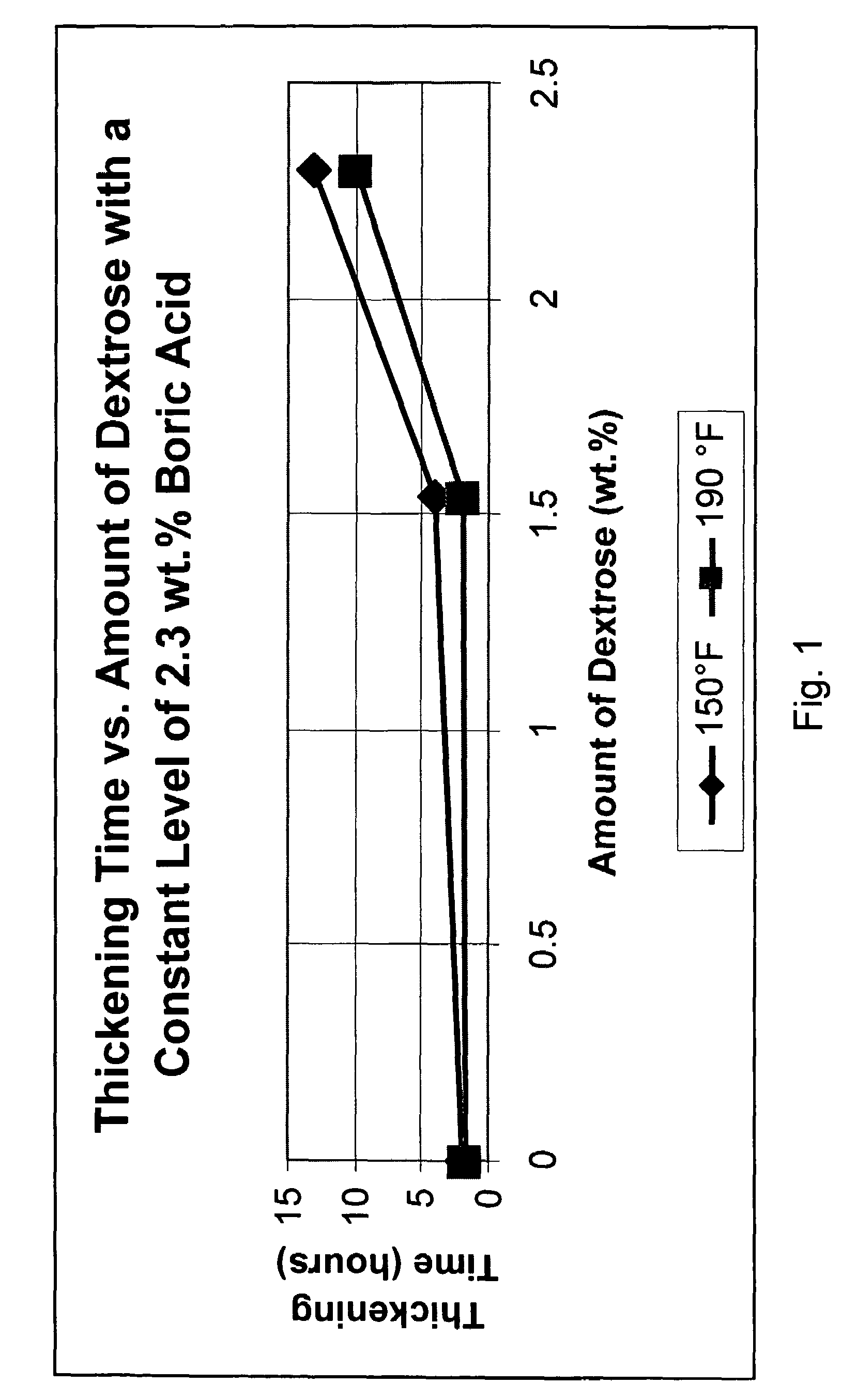Methods of increasing the thickening times of phosphate-based cementitious compositions in high-temperature wellbores
a technology of phosphate-based cementitious compositions and high-temperature wellbores, which is applied in the direction of wellbore/well accessories, sealing/packing, flushing, etc., can solve the problems of difficulty in using such compositions in well cementing, several weeks of delay in the completion of the wellbore, and unacceptably short composition time, etc., to increase the thickening time of the cementitious composition and slow the effect of ra
- Summary
- Abstract
- Description
- Claims
- Application Information
AI Technical Summary
Benefits of technology
Problems solved by technology
Method used
Image
Examples
example 1
[0019]Three samples of cementitious compositions or slurries were prepared that contained varying amounts of boric acid and no sugar, as shown in Table 1 below. Each sample further contained 11.5% MgO, 38.5% KH2PO4, 50% pozzolan-A, 30.8% water. The thickening time of each sample was measured using an HP-HT consistometer at a temperature of 190° F. and a pressure of 3,000 psi. As specified in the foregoing API procedure, the thickening time was determined to be the elapsed time from the initial application of the temperature and the pressure to the time at which the slurry reaches a consistency deemed sufficient to make it unpumpable (i.e., 70 Bc). The results of these measurements are shown in Table 1 below.
[0020]
TABLE 1SampleAmount ofAmount ofTemperature,Thickening Time,No.Boric Acid, %Dextrose, %° F.hr.:min.1NoneNone1900:1021.54None1900:4032.3None1901:40
Based on the results depicted in Table 1, the thickening time of the cementitious composition samples increased by relatively sma...
example 2
[0021]The same procedure followed in Example 1 was used to prepare and test two cementitious composition samples with the exception that varying amounts of dextrose were used and no boric acid was employed, as shown in Table 2 below. The thickening times of these examples are also depicted in Table 2.
[0022]
TABLE 2SampleAmount ofAmount ofTemperature,Thickening Time,No.Boric Acid, %Dextrose, %° F.hr.:min.4NoneNone1900:105None2.31900:10
The results in Table 2 indicate that using dextrose in the absence of boric acid did not affect the thickening time of the samples at 190° F. and a dextrose concentration even as high as 2.3%.
example 3
[0023]The same procedure followed in Example 1 was followed to prepare and test two cementitious composition samples with the exception that varying amounts of dextrose and 2.3% boric acid were used, as shown in Table 3 below. Also, the thickening time of each sample was measured at a temperature of 150° F. and at 190° F. under a pressure of 3,000 psi. The results of these measurements are presented in Table 3. In addition, FIG. 1 depicts a plot of the thickening time as a function of the amount of dextrose used at both 150° F. and 190° F.
[0024]
TABLE 3SampleAmount ofAmount ofTemperature,Thickening Time,No.Boric Acid, %Dextrose, %° F.hr.:min.62.31.54150 4:0072.32.315013:0082.31.54190 2:0092.32.319011:00
[0025]As illustrated by FIG. 1 and Table 3, while dextrose alone did not increase the thickening time of phosphate-based cementitious compositions, it worked synergistically with the boric acid to retard the thickening of such cementitious compositions even at higher temperatures and p...
PUM
| Property | Measurement | Unit |
|---|---|---|
| ambient temperatures | aaaaa | aaaaa |
| temperature | aaaaa | aaaaa |
| temperatures | aaaaa | aaaaa |
Abstract
Description
Claims
Application Information
 Login to View More
Login to View More - R&D
- Intellectual Property
- Life Sciences
- Materials
- Tech Scout
- Unparalleled Data Quality
- Higher Quality Content
- 60% Fewer Hallucinations
Browse by: Latest US Patents, China's latest patents, Technical Efficacy Thesaurus, Application Domain, Technology Topic, Popular Technical Reports.
© 2025 PatSnap. All rights reserved.Legal|Privacy policy|Modern Slavery Act Transparency Statement|Sitemap|About US| Contact US: help@patsnap.com


